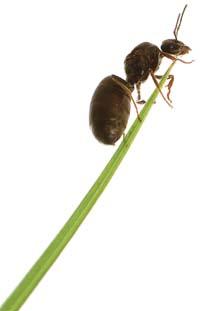Proportionately adequate, otherwise only

If an ant falls to the ground from a height of two meters, it is not a fatal accident. We have seen it many times and it does not attend to us. On the contrary, it seems normal for us not to die the ant by such a leap.
In fact, the numbers of the jump are spectacular. The fall of two meters of the 5 millimeters long ant represents a jump of 400 times the size of the body for the insect gajo. If a person of 1.70 meters jumped in the same proportion would fall by a height of 680 meters. Take accounts.
And conversely, for a person it is not difficult to get into the water, but an ant has no strength for it, since the surface tension of the water is too high. For the ant, the surface of the water is like a wall. You should open a hole to enter the water. In fact, if the ant is trapped inside a drop of water, it does not have enough force to go out and dies drowned.
It is the influence of proportions. Changing proportions, everything changes. What happens on a small scale does not happen with a large size. What works in a full glass of seawater does not work in the ocean. In the glass water can be easily won with a teaspoon, while the ocean does not shake well, neither the giant currents, nor the movement of the planet, nor earthquakes, etc. It is also impossible to completely mix the water next to the surface and the water in depth.
The same happens to the atmosphere. If gases are mixed as a laboratory vessel, meteorology would be an exact science. There would be wind, but there would be no wind and it would not be necessary to predict the weather. The atmosphere would be practically immobile. But, by its size, it doesn't happen that way. The atmosphere is very variable and the prediction is very complex.
The influence of proportions on the size of the planet is expected to be very high, but it also occurs on a much smaller scale. In technological processes, as is the case with industry, proportion changes are very important.
It is possible that a chemical reaction that works properly in the laboratory, for example, is difficult to perform in a 100 liter tank, since the substances that must react are not mixed properly. Or because too fast heating or cooling is reacting too much at once. Or acidification, or otherwise.
It is easy, for example, to synthesize polymers in a test tube, simply adding substances that need to react. However, to form polymer in a ten liter container it is necessary to use emulsion techniques so that within the mixture microburbuiles are formed and the reaction occurs within these microburbuilas. If not, the heat produced by the reaction collapses the entire process in a short time since its inception. It is no wonder that in the chemical industry the installation is more expensive than chemicals. And all for working with large amounts.
And the question is why? What changes from an ant to a person's jump? What changes from a glass to the ocean? Or from laboratory to industrial production?
The key is physical laws. Proportions change, but physical laws do not change.
For an ant and a person, for example, the constant of universal gravitation is the same number. Of course, the "downward" acceleration caused by the Earth on the ant is the same as that affecting a person, but since the ant has a much smaller mass, this acceleration produces a much smaller force. As a result, the strength to bear when hitting the ground is not enough to kill the ant.
Logically, in addition to gravity, in the case of the ant other characteristics should be taken into account. For example, chitin exoskeleton is much harder than human skin. Provides great protection to the ant.
A human-sized animal cannot have a hard exoskeleton. Again it is a ratio problem. Being an exoskeleton of chitin, man would have the same ant density and weigh hundreds of kilos. You could not move.
No joke. The change of proportions has a compensation. We cannot be an exoskeleton of ants and, of course, it is not a good idea to jump from 600 meters.






